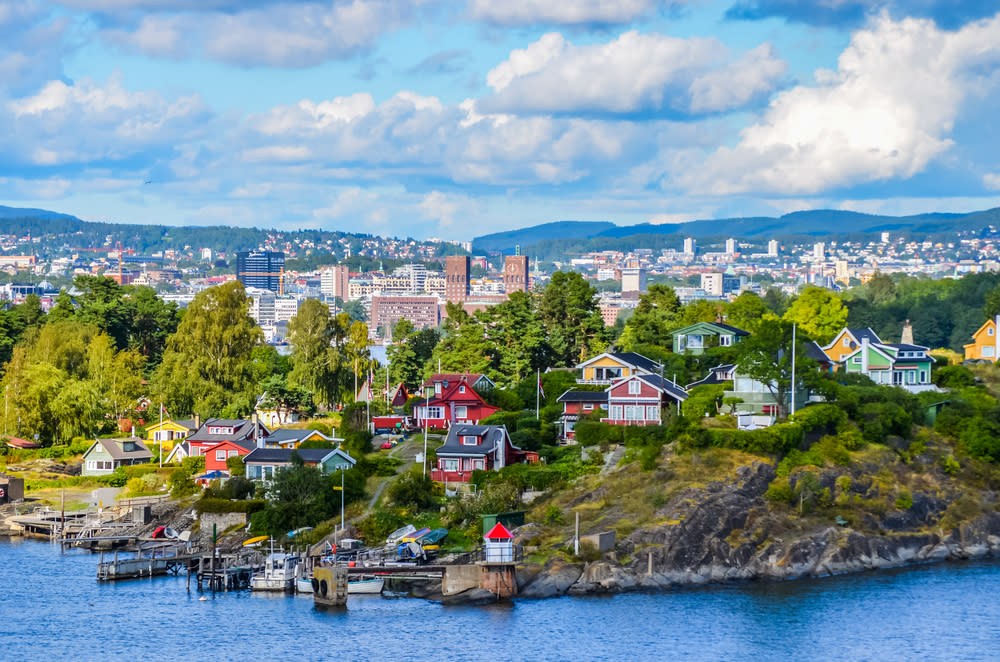More from Oslo
Main Menu
- 00:00
- 06:00
- 12:00
- 18:00
- 23:00
Oslo : Next 24-Hour Weather
Today - 16th April 2025
Sunrise 05:57
Sunset 20:38
Tomorrow - 17th April 2025
Sunrise 05:57
Sunset 20:38
Holiday Weather Now
Sorted by popularity:
Updated at 08:01 GMT
-
Temp feels like9°C49°F
-
Length of day14h 41m
-
Pressure29" (1000 hpa)
-
Visibility4 km (2miles)
-
Wind speed5 km/h
Sunrise 05:57
Sunset 20:38
-
Temp feels like:
9ºC (49 ºF)
-
Length of day:
14h 41m
-
Pressure:
29" (1000 hpa)
-
Visibility:
2 miles (4 km)
-
Wind speed:
5 km/h
Weather overview of Oslo , Norway
The climate in Oslo is fairly mild considering its northerly latitude. This is due to its coastal position and the influence of the warm Gulf Stream from the Atlantic. It is often associated with extreme cold but it enjoys some of the warmest summer temperatures in Scandinavia and its winters are warmer than inland and northern areas of Norway. Summers are generally pleasant and mild with plenty of long sunny days. Winters are cold; temperatures hover below freezing and snow blankets the city. Rain is likely at any time of the year but most of the annual rainfall occurs in late summer and early autumn.
Summer in Oslo can see a good deal of fine weather. When the sun is out, very comfortable temperatures in the low 20s are frequently enjoyed. July and August are the warmest months with daily highs frequently in the low the 20s. The temperature can rise up to the 30s but not often. At night, the temperature usually gets down to the teens.
As in the UK, the weather is highly unpredictable because of winds from the Atlantic so these temperatures are not guaranteed. Be prepared for all eventualities. You could get a week of fine sun and hot temperatures during your visit or it could rain everyday. Rainfall increases from the start of the season to a peak in August. It falls for about half of the days in each month but showers are heavier towards the end of summer.
Perhaps the best thing about summer in Norway is the amount of daylight â" there are just 5 hours between sunset and sunrise in Oslo in June. However, this makes the 8 hours of sunshine per day slightly less impressive.
Youâre unlikely to want to swim in the sea around Oslo; the peak water temperature, in July and August, is 17ºC. This is actually about the same as the sea around the UK in midsummer so if youâre one of âthose peopleâ jump right in.
Autumn is cold and wet. The temperatures quickly drop, the days shorten and the sun becomes awfully shy. The difference between summer and winter weather in Oslo is large and so autumn is a time of rapid change. The average high drops from 14ºC in September to 7ºC in October. From the beginning of October frost often develops at night. Rainfall is high for most of the season until it gets too cold and turns to snow. Snow sports enthusiasts eagerly await the first snowfall, which normally arrives in November. Novemberâs average temperature is -1ºC.
Winter is a sad story. The sun rises late at 9am, only to set again at 3pm. It is a dark and gloomy time. Average temperatures are below zero from November right through until March. January is the coldest month with an average high of -2ºC and an average low of -9ºC. While extreme cold is rare, it has been known to get as cold as -25ºC in Oslo.
The short days are often overcast and you can go for weeks without sunshine. Things can be a little miserable in winter. However, it is a great time for snow sports and there is even a ski resort within the city limits. All precipitation falls as snow from December till February.
Spring is a time of rapid change as temperatures rise, snow melts and the sun returns. It is the driest time of year with only light showers, but water is abundant as the snow begins to melt in March. With subzero temperatures into April at night, melted snow often refreezes causing dangerous conditions on the roads. Early spring is still chilly but late spring sees an average high of 14ºC. Up in the mountains the snow doesnât budge until the end of the season so itâs the best time to ski as it is warmer and the longer days are sunnier.

















